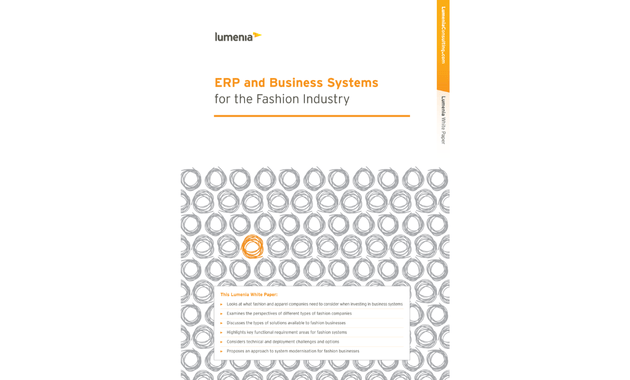ERP & Business Systems for the Fashion Industry
The fashion supply chain is both complex and agile. The advent of global supply, “fast fashion”, eCommerce, mobile commerce, social media and other digital trends means that the time from design to sale has reduced dramatically and that consumer choice and expectation has grown accordingly. Consumers are driving changes in the industry, and the ability to listen to them and respond quickly while managing an ever-evolving supply chain is a huge challenge for fashion companies.
The position that an organisation holds in this chain, as well as the nature of its offering, will determine the challenges it faces and the technology and business process solutions that it needs.
Lumenia Consulting’s latest white paper ERP and Business Systems for the Fashion Industry addresses the factors that fashion and apparel companies need to consider when investing in new or replacement business systems to support their product development, supply chain, retail and back office operations.

The white paper examines the different perspectives that companies might need to consider based on their position in the supply chain position, their organisation or group structure, their geographical spread, brand offering (quality and price point) and whether the organisation owns and develops its own brands or markets others.
The white paper goes on to examines the potential approaches a business can take towards its business systems, from specialist point solutions to integrated fashion focused ERP systems. In the point solution world, there would be a core Finance or ERP system sitting alongside point solutions for areas such as PLM, Merchandising, Planning and Supply Chain Management. Whereas, in the ERP world, there would be one single integrated solution covering all these areas. There is rarely a one size fits all strategy for any business, as the exact mix will be determined by the existing systems and potential benefits.
The white paper recognises that there are a number of key core concepts within fashion businesses which many systems cannot handle, such as how to manage multiple seasons, how to treat the style/colour/size matrix, and the use of ratio packs, which have a large impact on how well a system functions. The paper examines these in more detail, the impact they could have on the business system strategy, and how some ERP providers have developed fashion specific solutions for these. The paper then outlines some of the key functional requirements that are important to fashion businesses in comparison to other businesses.
In any project there will be a degree of integration with other systems, from external customers and suppliers through to internal point solutions, although, the complexity and depth of these will be defined by the preferred enterprise system strategy. The paper examines a few of the key areas where integrations may be required in more detail, such as the management of master data, how the POS will integrate with the other systems, and how the business will trade electronically with its customers and suppliers, before looking at how best to support these and any other integrations.
To complete the picture, the paper considers the impact a particular business system strategy will have on the cost, timescale and risk of the implementation project.
To obtain a copy of this white paper, please visit the Reports & White Papers section of the website where you can download a copy for free or send an email to info@lumeniaconsulting.com
This blog and white paper was written by Paul Muspratt Principal Consultant & Ian O'Toole, Managing Partner at Lumenia. For further information on Lumenia or on ERP and Business Systems for the Fashion Industry send an email to Paul Muspratt.


